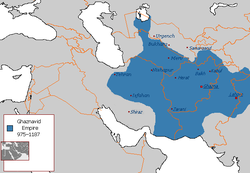ग़ज़नवी साम्राज्य
ग़ज़नवी राजवंश (फ़ारसी: غزنویان) एक तुर्क मुसलमान राजवंश था जिसने ९७५ ईसवी से ११८६ ईसवी काल में अधिकाँश ईरान, आमू पार क्षेत्रों और उत्तरी भारतीय उपमहाद्वीप पर राज किया। इसकी स्थापना सबुक तिगिन ने तब की थी जब उसे अपने ससुर अल्प तिगिन की मृत्यु पर ग़ज़ना (वर्तमान ग़ज़नी प्रांत) का राज मिला था। अल्प तिगिन स्वयं कभी ख़ुरासान के सामानी साम्राज्य का सिपहसालार हुआ करता था जिसने अपनी अलग रियासत क़ायम कर ली थी।[5] इन्हें भारतीय सूत्रों में गर्जन तथा गर्जनक कहा गया है और इनके सुल्तान को गर्जनेश तथा गर्जनकाधिराज।
| ग़ज़नवियान गर्जन गर्जनक | |||||
| |||||
 सन् 1030 में ग़ज़नवी साम्राज्य अपने चरम पर।
| |||||
| राजधानी | ग़ज़ना (९६३–११६३) लाहौर (११६३–११८६)[1] | ||||
| भाषाएँ | फ़ारसी (राजभाषा और आम-भाषा)[2][3] अरबी (धार्मिक) तुर्की (सैनिक)[4] | ||||
| धार्मिक समूह | सुन्नी इस्लाम | ||||
| शासन | साम्राज्य | ||||
| सुल्तान (महमूद के दौर से) | |||||
| - | ९६१-९६३ | सबुक तिगिन (प्रथम) | |||
| - | ११६०-११८६ | ख़ुसरो मालिक (अंतिम) | |||
| ऐतिहासिक युग | मध्यकालीन | ||||
| - | स्थापित | ९६३ | |||
| - | अंत | ११८६ | |||
| क्षेत्रफल | |||||
| - | १०२९ अनुमानित | 34,00,000 किमी ² (13,12,747 वर्ग मील) | |||
| आज इन देशों का हिस्सा है: | |||||
| Warning: Value specified for "continent" does not comply | |||||
महमूद ग़ज़नवी द्वारा साम्राज्य विस्तार संपादित करें
सबुक तिगिन का पुत्र, महमूद ग़ज़नी ने ग़ज़नवी साम्राज्य की सीमाओं को बहुत बढ़ाया और अपने राजक्षेत्र को उत्तर में आमू दरिया से लेकर पूर्व में सिन्धु नदी तक और दक्षिण में अरब सागर तक विस्तृत कर दिया। तुर्क नस्ल के होने के बावजूद ग़ज़नवी वंश सामानी साम्राज्य की ईरानी-फ़ारसी सभ्यता से प्रभावित था। वह सैनिक अभियानों में तुर्की भाषाएँ प्रयोग करता था लेकिन राजदरबार और संस्कृति में फ़ारसी इस्तेमाल करता था।
साम्राज्य का पतन संपादित करें
मसूद प्रथम (१०३१-१०४१) के शासनकाल में ग़ज़नवी अपना पश्चिमी क्षेत्र सन् १०४० में लड़े गए दंदानाक़ान के युद्ध में सलजूक़ साम्राज्य को खो बैठे।[6] इसके बाद उनका साम्राज्य सिकुड़ कर आधुनिक अफ़ग़ानिस्तान, बलोचिस्तान और पंजाब तक सीमित रह गया। ११५१ में सुलतान बहराम शाह के राजकाल में ग़ज़नवी साम्राज्य स्वयं ग़ज़नी को भी ग़ोर के अलाउद्दीन हुसैन को हार गया।
इन्हें भी देखें संपादित करें
सन्दर्भ संपादित करें
- ↑ "Lahore" Encyclopædia Britannica
- ↑ Homa Katouzian, "Iranian history and politics", Published by Routledge, 2003. pg 128: "Indeed, since the formation of the Ghaznavids state in the tenth century until the fall of Qajars at the beginning of the twentieth century, most parts of the Iranian cultural regions were ruled by Turkic-speaking dynasties most of the time. At the same time, the official language was Persian, the court literature was in Persian, and most of the chancellors, ministers, and mandarins were Persian speakers of the highest learning and ability"
- ↑ "Persian Prose Literature." World Eras. 2002. HighBeam Research. (September 3, 2012);"Princes, although they were often tutored in Arabic and religious subjects, frequently did not feel as comfortable with the Arabic language and preferred literature in Persian, which was either their mother tongue—as in the case of dynasties such as the Saffarids (861–1003), Samanids (873–1005), and Buyids (945–1055)— or was a preferred lingua franca for them—as with the later Turkish dynasties such as the Ghaznawids (977–1187) and Saljuks (1037–1194)". [1]
- ↑ C.E. Bosworth, The Ghaznavids:994-1040, (Edinburgh University Press, 1963), 134.
- ↑ First encyclopaedia of Islam: 1913-1936 Archived 2013-08-29 at the वेबैक मशीन, Martijn Theodoor Houtsma, pp. 162, BRILL, ISBN 978-90-04-09796-4, ... About 350 (961) a Turkish slave named Alp-tegin who had been Hadjib or Chamberlain under the Samanide king 'Abd al-Malik rebelled against his successor Mansur, and took possession of the town of Ghaznin ...
- ↑ The Empire of the Steppes: A History of Central Asia Archived 2011-11-07 at the वेबैक मशीन, René Grousset, pp. 147, Rutgers University Press, 1970, ISBN 978-0-8135-1304-1, ... On May 22, 1040, the Ghaznavids had been beaten at the battle of Dandanaqan, near Merv, by another Turkic band, the Seljuks, who had captured Khurasan from them and driven them back into Afghanistan and India ...